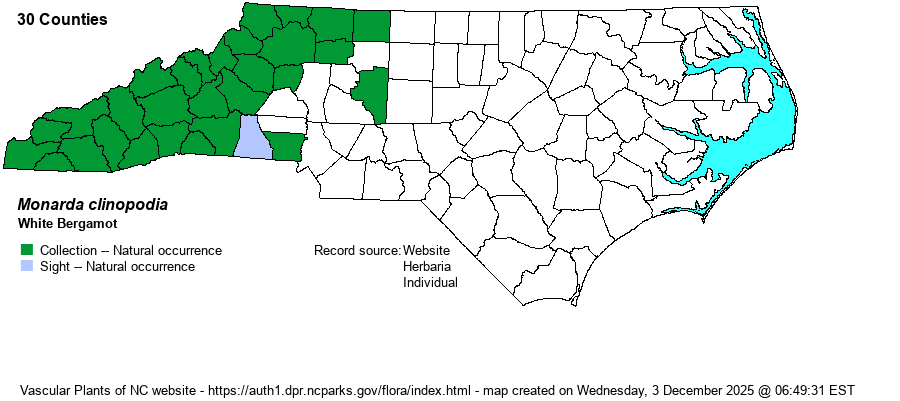| Author | L. | |
| Distribution | Throughout the Mountains, and present in the western Piedmont, east sparingly as far as Stokes, Davidson, and Gaston counties.
This is a Northeastern species, ranging from NY and IL, south though the Appalachians and Cumberlands to northern GA and northern AL. | |
| Abundance | Common and widespread in the Mountains, recorded from all counties. Uncommon to infrequent in the higher Piedmont foothills ranges, but rare at lower elevations eastward. This is one of the relatively few primarily montane species in the state given an S5 State Rank by the NCNHP. | |
| Habitat | This has a wide array of forested habitats, though typically in mesic to rich deciduous forests. It is a common component of Rich Cove Forests, but also is found in various oak forests, Northern Hardwoods Forests, and others as well. | |
| Phenology | Blooms from late May to September, and fruits from September to October. | |
| Identification | This is the most commonly seen Monarda in the western half of the state, familiar to people walking along mountain trails in the summer months. It has a stem growing to about 2-2.5 feet tall, simple or branched somewhat, with a scattering of opposite leaves like others in the genus. The leaves are ovate to lanceolate with acuminate tips, serrated along the margins, with a rounded base and a petiole about 3/4-inch long. The blades average 3-4 inches long and about 1-inch wide. At the top of each stem/branch is the flower cluster, with numerous (often about 15-20 in bloom at a time), large and "skinny" white to very pale pink or pale greenish-white flowers, each one with a slender upper lip and a slender lower one with a wide-open "mouth", facing outward from the central axis of the cluster; each flower is about 1-inch long. Other Monarda species growing in the mountains have different flower colors -- M. media (purple), M. didyma (red), and M. fistulosa (bright pink), in addition to a few other more technical characters. | |
| Taxonomic Comments | None
| |
| Other Common Name(s) | Basil Bergamot, Basil Beebalm | |
| State Rank | S5 | |
| Global Rank | G5 | |
| State Status | | |
| US Status | | |
| USACE-agcp | FACU link |
| USACE-emp | FACU link |

